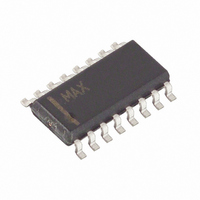DS2711Z+ Maxim Integrated Products, DS2711Z+ Datasheet - Page 7

DS2711Z+
Manufacturer Part Number
DS2711Z+
Description
IC NIMH CHARGER 16SOIC
Manufacturer
Maxim Integrated Products
Datasheet
1.DS2712Z.pdf
(15 pages)
Specifications of DS2711Z+
Function
Charge Management
Battery Type
Nickel Metal Hydride (NiMH)
Voltage - Supply
4 V ~ 5.5 V
Operating Temperature
-20°C ~ 70°C
Mounting Type
Surface Mount
Package / Case
16-SOIC (0.154", 3.90mm Width)
Operating Supply Voltage
5.5 V
Supply Current
250 uA
Maximum Operating Temperature
+ 70 C
Minimum Operating Temperature
- 20 C
Charge Safety Timers
Yes
Mounting Style
SMD/SMT
Temperature Monitoring
Yes
Uvlo Start Threshold
3.5 V
Uvlo Stop Threshold
40 mV
Lead Free Status / RoHS Status
Lead free / RoHS Compliant
DS2711/DS2712: Loose Cell NiMH Charger
DETAILED DESCRIPTION
Charge Algorithm Overview
A charge cycle begins in one of three ways: with the application of power to the DS2711 with cell(s) already
inserted, with the detection of cell insertion after power-up, or when exiting suspend mode with cell(s) inserted. The
charge cycle begins with precharge qualification to prevent fast charging of deeply depleted cells or charging under
extreme temperature conditions. precharging is performed at a reduced rate until each cell reaches 1V. The
algorithm proceeds to a fast-charge phase, which includes cell tests to avoid accidental charging of alkaline cells or
NiMH cells that are worn-out or damaged. Fast charging continues as long as the cell temperature(s) are less than
50°C (based on THM1, THM2 voltages) and the open-circuit cell voltage(s) are between 1.0V and 1.75V. Fast
charging terminates by the -ΔV (negative delta voltage) method. The top-off charge phase follows to completely
charge the cells. After the top-off charge timer expires, the maintenance charge phase continues indefinitely to
keep the cells at a full state of charge. Maximum voltage, temperature, and charge-time monitoring during all
charge phases act as secondary or safety termination methods to provide additional protection from overcharge.
Each cell is monitored independently, and in parallel mode the charge phase of each cell is independently
controlled.
Series Charge Configuration
The DS2711/DS2712 series configuration supports one or two-slot stand-alone and one or two cell in-system
chargers. The single-cell-series mode charges one cell while the two-cell-series mode charges two series cells.
Since the cells are charged in series, cell sizes should not be mixed in the series configuration. In the application
example in Figure 3, charge current is gated to the battery cells by a PNP transistor under the control of the CC1
pin of the DS2711. Current regulation is performed outside of this example schematic using the current-sense
feedback provided by the DS2711 CSOUT pin. The DS2712 can also be used in this circuit to provide switch-mode
control on the CSOUT pin. RSNS = 0.125Ω sets the charge source current, ICHG, to 1A. In series mode, the
effective charge current is 0.969 x ICHG = 969mA.
Figure 3. SERIES CONFIGURATION WITH EXTERNAL CURRENT
REGULATION
7 of 15












